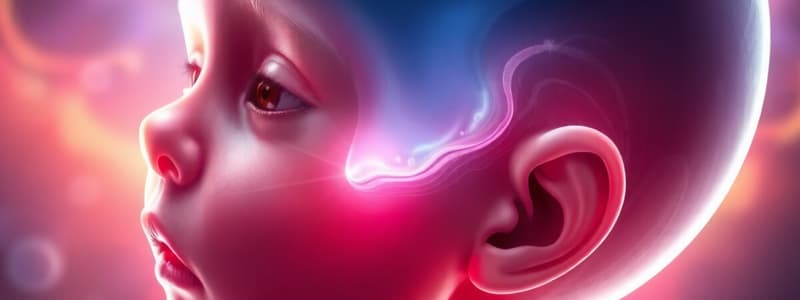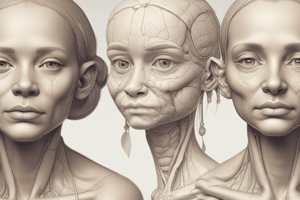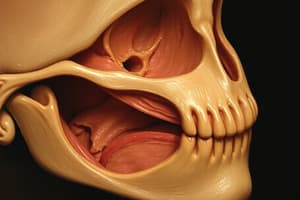Podcast
Questions and Answers
Which structure is formed from the intermaxillary segment?
Which structure is formed from the intermaxillary segment?
- Lateral nasal prominences
- Philtrum of the lip (correct)
- Mandibular prominences
- Maxillary prominences
What occurs when tissues fail to undergo proper merging during facial development?
What occurs when tissues fail to undergo proper merging during facial development?
- Clefting (correct)
- Formation of the primary palate
- Merging
- Fusion
What is the main difference between merging and fusion in facial development?
What is the main difference between merging and fusion in facial development?
- Fusion leads to facial clefts.
- Merging is continuous mesenchyme without tissue separation. (correct)
- Merging involves separate tissues.
- Fusion requires continuous mesenchyme.
Which structure forms the alae of the nose?
Which structure forms the alae of the nose?
At what stage does the oronasal membrane rupture, creating a single oronasal cavity?
At what stage does the oronasal membrane rupture, creating a single oronasal cavity?
What primarily composes the hard palate?
What primarily composes the hard palate?
What initiates the formation of the nasal cavity?
What initiates the formation of the nasal cavity?
When is the secondary palate fully formed and joined, further separating the oral and nasal cavities?
When is the secondary palate fully formed and joined, further separating the oral and nasal cavities?
What type of cleft is formed if the medial nasal prominences do not completely merge?
What type of cleft is formed if the medial nasal prominences do not completely merge?
Which of the following best describes macrostomia?
Which of the following best describes macrostomia?
What structure is formed from the first pharyngeal pouch?
What structure is formed from the first pharyngeal pouch?
Which pharyngeal arch cartilage is associated with the stapes?
Which pharyngeal arch cartilage is associated with the stapes?
What does the foramen cecum represent in tongue development?
What does the foramen cecum represent in tongue development?
Which of the following cranial nerves innervates the anterior two-thirds of the tongue for general sensation?
Which of the following cranial nerves innervates the anterior two-thirds of the tongue for general sensation?
What is the result of a failure of the lateral lingual swellings to merge completely?
What is the result of a failure of the lateral lingual swellings to merge completely?
What type of cleft palate is described by affecting only the soft portions?
What type of cleft palate is described by affecting only the soft portions?
Which structure does the second pharyngeal pouch contribute to?
Which structure does the second pharyngeal pouch contribute to?
What happens to the inferior parathyroid glands during development?
What happens to the inferior parathyroid glands during development?
What is a common result of failure in the merging of the maxillary and mandibular prominences?
What is a common result of failure in the merging of the maxillary and mandibular prominences?
Which of the following captures the function of the pharyngeal membrane?
Which of the following captures the function of the pharyngeal membrane?
What can occur as a remnant of the thyroglossal duct?
What can occur as a remnant of the thyroglossal duct?
Flashcards
Fusion
Fusion
The process where two different tissues come together and connect, but remain distinct. This happens during the development of the face and palate, forming structures like the chin and upper lip.
Merging
Merging
The process where continuous mesenchyme (embryonic tissue) between the ectoderm and endoderm allows facial prominences to grow and fuse together. This is essential for the majority of facial development.
Primary Palate
Primary Palate
The primary palate forms from the expansion of deeper portions of the intermaxillary segment, which originates from the merging of the medial nasal prominences. It forms the anterior portion of the palate, including the upper incisor teeth.
Secondary Palate
Secondary Palate
Signup and view all the flashcards
Intermaxillary Segment
Intermaxillary Segment
Signup and view all the flashcards
Facial Cleft
Facial Cleft
Signup and view all the flashcards
Oblique Facial Cleft
Oblique Facial Cleft
Signup and view all the flashcards
Median Cleft Lip
Median Cleft Lip
Signup and view all the flashcards
Unilateral Cleft Lip
Unilateral Cleft Lip
Signup and view all the flashcards
Bilateral Cleft Lip
Bilateral Cleft Lip
Signup and view all the flashcards
Anterior Facial Clefts
Anterior Facial Clefts
Signup and view all the flashcards
Partial Anterior Cleft
Partial Anterior Cleft
Signup and view all the flashcards
Posterior Cleft Palate
Posterior Cleft Palate
Signup and view all the flashcards
Complete Posterior Cleft
Complete Posterior Cleft
Signup and view all the flashcards
Partial Posterior Cleft
Partial Posterior Cleft
Signup and view all the flashcards
Macrostomia
Macrostomia
Signup and view all the flashcards
Microstomia
Microstomia
Signup and view all the flashcards
Pharyngeal Arch
Pharyngeal Arch
Signup and view all the flashcards
Meckel's Cartilage
Meckel's Cartilage
Signup and view all the flashcards
Reichert's Cartilage
Reichert's Cartilage
Signup and view all the flashcards
Ankyloglossia (Tied Tongue)
Ankyloglossia (Tied Tongue)
Signup and view all the flashcards
Study Notes
Face and Palate Development
- Facial primordia are continuous with internal tissues, structures derived from the same tissue include the primary palate and philtrum.
- Intermaxillary segment forms the philtrum of the lip and primary palate.
- Mandibular prominences form the lower lip, chin, and outer cheeks.
- Maxillary prominences form lateral parts of the upper lip, inner cheek.
- Frontal nasal prominences form forehead, nose dorsum, apex, alae, philtrum, and primary palate.
- Merging vs. Fusion: Merging requires continuous mesenchyme between ectoderm and endoderm; this is key to most facial development. Fusion is the joining of 2 separate tissues. Clefting results from failure of merging or fusion.
- Nasal Prominence Formation: Medial nasal prominences merge to form the intermaxillary segment, which fuses with maxillary prominences to form the alae of the nose. Lateral nasal prominences merge with the maxillary prominences.
- Primary and Secondary Palate Formation: Primary palate forms from the expansion of the intermaxillary segment, driven by medial growth of facial prominences. The secondary palate forms the rest of the hard and soft palate, also through medial growth of facial prominences.
- Nasal Cavity Development: Begins as a nasal pit in the nasal placode, invaginating to form a nasal sac.
- Oral and Nasal Cavity Separation: A thin oronasal membrane initially separates the oral and nasal cavity. Enlargement of the nasal cavity and rupture of the membrane create a single oronasal cavity (primitive choana); complete separation occurs by 12 weeks with the formation of the secondary palate.
- Hard vs. Soft Palate: Both are parts of the mouth roof. Hard palate is primarily bone, forming the anterior portion; soft palate is mainly muscle and connective tissue, forming the posterior portion, ending in the uvula.
- Major Face and Palate Defects (Embryological Basis): Facial clefts (e.g., oblique, medial/median), cleft lip (unilateral/bilateral), and cleft palate (primary/secondary) occur due to failure of tissue merging or fusion at different stages of development. Variations in the size of the mouth (macrostomia/microstomia) can also occur.
- Oblique facial cleft: failure of maxillary and lateral nasal prominences to merge.
- Median cleft lip: failure of medial nasal prominences to merge in the intermaxillary segment region.
- Anterior clefts (lip only): failure of merging between intermaxillary segment and maxillary prominences.
- Primary cleft palate: incomplete fusion of the primary palate.
- Secondary cleft palate: failure of fusion between the palatine processes. -Complete posterior cleft: affects both hard and soft portions of secondary palate. -Partial posterior cleft: affects a portion of the secondary palate.
- Macrostomia: failure of lateral maxillary and mandibular prominences to merge.
- Microstomia: excessive merging of maxillary and mandibular prominences.
Pharyngeal Arch Development
- Each pharyngeal arch contains an aortic arch, cartilage, muscle, and a cranial nerve. It's externally lined by ectoderm and internally by endoderm.
- Invaginations between arches: external (pharyngeal grooves/clefts) and internal (pharyngeal pouches).
- Pharyngeal membranes are formed where ectoderm and endoderm layers meet.
- Arch 1 (Meckel's cartilage): Dorsal part contributes to the incus and malleus (middle ear bones); ventral part is a precursor to the mandible.
- Arch 2 (Reichert's cartilage): Dorsal part contributes to the stapes (middle ear bone); ventral part contributes to parts of the hyoid bone.
- Arch 3: Forms parts of the hyoid bone.
- Arches 4 & 6: Contribute to laryngeal cartilages.
- Groove 1: Forms the external auditory meatus.
- Grooves 2, 3, & 4: Obliterated by overgrowth, forming the cervical sinus (which usually disappears).
- Pouch 1: Forms the tubotympanic recess, tympanic cavity, and auditory tube.
- Pouch 1 Membrane: Becomes the tympanic membrane.
- Pouch 2: Forms the fossa for palatine tonsils.
- Pouch 3: Forms inferior parathyroid glands and thymus.
- Pouch 4: Forms superior parathyroid glands and the ultimobranchial body (part of thyroid).
Tongue Development
- Tongue develops from swellings on the pharynx floor, associated with pharyngeal arches.
- Arch 1: Forms the primary tongue (tuberculum impar), later overgrown by lateral lingual swellings.
- Arch 2: Forms the copula, mostly lost during development.
- Arches 3 & 4: Hypobranchial eminence overgrows the copula.
- Tongue prominences merge: medial and terminal sulcus are formed.
- Foramen cecum is the site of thyroid gland invagination.
- Sensory innervation reflects arch origin; anterior 2/3 (CN V3); posterior 1/3 (CN IX, some CN X).
- Taste buds develop (weeks 11-13). Taste innervation to anterior 2/3 (CN VII); posterior tongue (CN IX, some CN X).
- Intrinsic tongue muscles (CN XII) come from occipital somites, not arches.
- Tongue Malformations: Ankyloglossia (tied tongue), bifid tongue, macroglossia/microglossia.
Thyroid Formation
- Thyroid develops from endoderm in the pharynx floor.
- A proliferating mass forms at the foramen cecum.
- Descends through the neck within a thyroglossal duct, which typically disappears.
- Persistence can lead to a cyst or sinus.
- Functional by week 10.
Studying That Suits You
Use AI to generate personalized quizzes and flashcards to suit your learning preferences.


